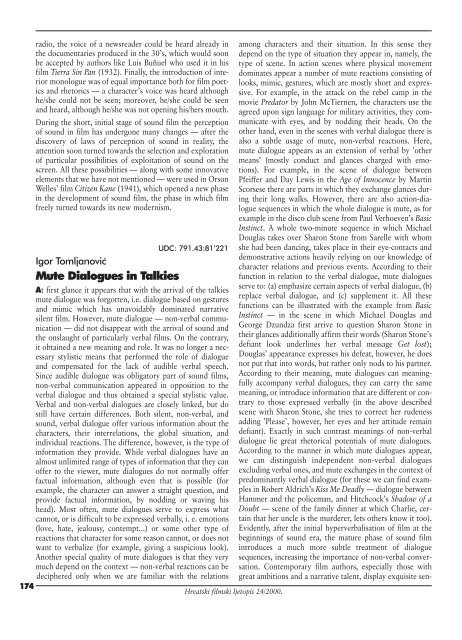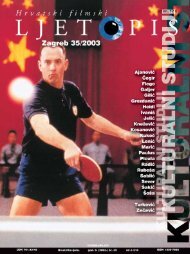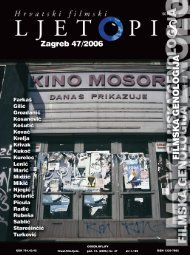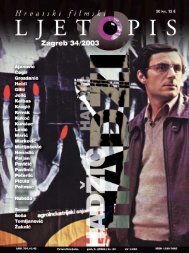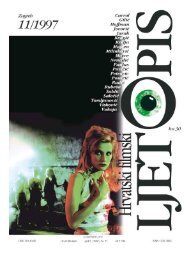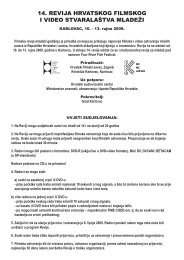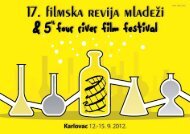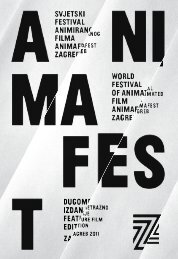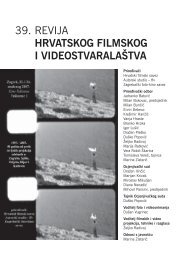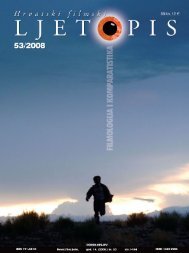Create successful ePaper yourself
Turn your PDF publications into a flip-book with our unique Google optimized e-Paper software.
adio, the voice of a newsreader could be heard already in<br />
the documentaries produced in the 30’s, which would soon<br />
be accepted by authors like Luis Buñuel who used it in his<br />
film Tierra Sin Pan (1932). Finally, the introduction of interior<br />
monologue was of equal importance both for film poetics<br />
and rhetorics — a character’s voice was heard although<br />
he/she could not be seen; moreover, he/she could be seen<br />
and heard, although he/she was not opening his/hers mouth.<br />
During the short, initial stage of sound film the perception<br />
of sound in film has undergone many changes — after the<br />
discovery of laws of perception of sound in reality, the<br />
attention soon turned towards the selection and exploration<br />
of particular possibilities of exploitation of sound on the<br />
screen. All these possibilities — along with some innovative<br />
elements that we have not mentioned — were used in Orson<br />
Welles’ film Citizen Kane (1941), which opened a new phase<br />
in the development of sound film, the phase in which film<br />
freely turned towards its new modernism.<br />
Igor Tomljanovi}<br />
Mute Dialogues in Talkies<br />
UDC: 791.43:81’221<br />
At first glance it appears that with the arrival of the talkies<br />
mute dialogue was forgotten, i.e. dialogue based on gestures<br />
and mimic which has unavoidably dominated narrative<br />
silent film. However, mute dialogue — non-verbal communication<br />
— did not disappear with the arrival of sound and<br />
the onslaught of particularly verbal films. On the contrary,<br />
it obtained a new meaning and role. It was no longer a necessary<br />
stylistic means that performed the role of dialogue<br />
and compensated for the lack of audible verbal speech.<br />
Since audible dialogue was obligatory part of sound films,<br />
non-verbal communication appeared in opposition to the<br />
verbal dialogue and thus obtained a special stylistic value.<br />
Verbal and non-verbal dialogues are closely linked, but do<br />
still have certain differences. Both silent, non-verbal, and<br />
sound, verbal dialogue offer various information about the<br />
characters, their interrelations, the global situation, and<br />
individual reactions. The difference, however, is the type of<br />
information they provide. While verbal dialogues have an<br />
almost unlimited range of types of information that they can<br />
offer to the viewer, mute dialogues do not normally offer<br />
factual information, although even that is possible (for<br />
example, the character can answer a straight question, and<br />
provide factual information, by nodding or waving his<br />
head). Most often, mute dialogues serve to express what<br />
cannot, or is difficult to be expressed verbally, i. e. emotions<br />
(love, hate, jealousy, contempt...) or some other type of<br />
reactions that character for some reason cannot, or does not<br />
want to verbalize (for example, giving a suspicious look).<br />
Another special quality of mute dialogues is that they very<br />
much depend on the context — non-verbal reactions can be<br />
deciphered only when we are familiar with the relations<br />
174<br />
Hrvatski filmski ljetopis <strong>24</strong>/<strong>2000</strong>.<br />
among characters and their situation. In this sense they<br />
depend on the type of situation they appear in, namely, the<br />
type of scene. In action scenes where physical movement<br />
dominates appear a number of mute reactions consisting of<br />
looks, mimic, gestures, which are mostly short and expressive.<br />
For example, in the attack on the rebel camp in the<br />
movie Predator by John McTiernen, the characters use the<br />
agreed upon sign language for military activities, they communicate<br />
with eyes, and by nodding their heads. On the<br />
other hand, even in the scenes with verbal dialogue there is<br />
also a subtle usage of mute, non-verbal reactions. Here,<br />
mute dialogue appears as an extension of verbal by ’other<br />
means’ (mostly conduct and glances charged with emotions).<br />
For example, in the scene of dialogue between<br />
Pfeiffer and Day Lewis in the Age of Innocence by Martin<br />
Scorsese there are parts in which they exchange glances during<br />
their long walks. However, there are also action-dialogue<br />
sequences in which the whole dialogue is mute, as for<br />
example in the disco club scene from Paul Verhoeven’s Basic<br />
Instinct. A whole two-minute sequence in which Michael<br />
Douglas takes over Sharon Stone from Sarelle with whom<br />
she had been dancing, takes place in their eye-contacts and<br />
demonstrative actions heavily relying on our knowledge of<br />
character relations and previous events. According to their<br />
function in relation to the verbal dialogue, mute dialogues<br />
serve to: (a) emphasize certain aspects of verbal dialogue, (b)<br />
replace verbal dialogue, and (c) supplement it. All these<br />
functions can be illustrated with the example from Basic<br />
Instinct — in the scene in which Michael Douglas and<br />
George Dzundza first arrive to question Sharon Stone in<br />
their glances additionally affirm their words (Sharon Stone’s<br />
defiant look underlines her verbal message Get lost);<br />
Douglas’ appearance expresses his defeat, however, he does<br />
not put that into words, but rather only nods to his partner.<br />
According to their meaning, mute dialogues can meaningfully<br />
accompany verbal dialogues, they can carry the same<br />
meaning, or introduce information that are different or contrary<br />
to those expressed verbally (in the above described<br />
scene with Sharon Stone, she tries to correct her rudeness<br />
adding ’Please’, however, her eyes and her attitude remain<br />
defiant). Exactly in such contrast meanings of non-verbal<br />
dialogue lie great rhetorical potentials of mute dialogues.<br />
According to the manner in which mute dialogues appear,<br />
we can distinguish independent non-verbal dialogues<br />
excluding verbal ones, and mute exchanges in the context of<br />
predominantly verbal dialogue (for these we can find examples<br />
in Robert Aldrich’s Kiss Me Deadly — dialogue between<br />
Hammer and the policeman, and Hitchcock’s Shadow of a<br />
Doubt — scene of the family dinner at which Charlie, certain<br />
that her uncle is the murderer, lets others know it too).<br />
Evidently, after the initial hyperverbalisation of film at the<br />
beginnings of sound era, the mature phase of sound film<br />
introduces a much more subtle treatment of dialogue<br />
sequences, increasing the importance of non-verbal conversation.<br />
Contemporary film authors, especially those with<br />
great ambitions and a narrative talent, display exquisite sen-


